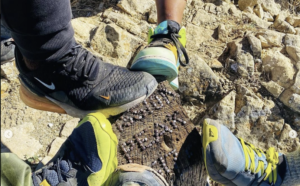Go looking for a hiking guide to the Napa area, and you’re immediately faced with the choice between two books with almost identical titles. With very similar photos on their covers. Even the authors’ names are somewhat similar.
The first, Great Day Hikes in and around Napa Valley, by Ken Stanton [Bored Feet Press, revised 2007, 231 pages, $16], was originally published in 1995, and is in its third edition; the second, Day Hikes around Napa Valley, by Robert Stone [Day Hike Books (www.globe-pequot.com), 2008, 288 pages, $16.95], is just out this year. Curiously, Stone acknowledges another Stanton book, Mount St. Helena and R. L. Stevenson State Park: a History and Guide, without mentioning Great Day Hikes, which he could hardly have been unaware of, though the similar title of his own book is understandable since it is the 23rd in a series of “Day Hikes Around” books he has published since 1991. So perhaps the confusing similarities could not be avoided. But interested hikers should take the trouble to choose wisely between them.
If you are unfamiliar with the North Bay area, and especially if you have only a casual interest in it, Robert Stone is your man. He starts with a clear overview map on which you can get your bearings, and it is easy to proceed from that to detailed maps for every hike he discusses. He’s written a lot of trail guides, and has a format that’s easy to follow, though the simplicity is achieved at the cost of information important to some readers (e.g. my own concern, wheelchair access, gets short shrift indeed). He writes as an outsider, ending with a list of half a dozen places he lodged while hiking the trails, all enthusiastically recommended. You’re unlikely to encounter bedbugs at these hotels, or get lost or surprised following his hiking directions either.
From its similar title, you wouldn’t expect the very different book Ken Stanton wrote, and has recently updated. Taken as a trail guide, it suffers for want of clear maps. The frontispiece overview of Napa County appears to be a dark photocopy, with place and highway names very difficult to read, and no key for locating trail sites. Scattered through the text, maps illustrating parks and trails seem to come from different sources; some are fine, others are darkly shaded topos reduced to half a page, and lacking useful captions. Stanton’s driving directions are clear; his hiking directions even clearer, and he explores obscure trails Stone probably never found out about. But his guide needs to be supplemented with a good local road map and probably park or topo maps as well.
However, once underway, you’ll know what you’re seeing. Each site’s human history both recent and ancient, from the lives of Wappo Indians to the fight against sudden oak death is recounted exhaustively. Likewise there’s much here about geology, flora, and fauna, though Stanton doesn’t claim to be a birder, referring to LBB’s (little brown birds) when he’s not noting sight of ospreys and pileated woodpeckers. At times, especially in the overview sections, he provides more information than a casual reader may want. Most useful are the precise trail descriptions helping the hiker identify rock formations, trees, shrubs and historic features: “Soon after commencing Coyote Trail look for a rock wall on the left. Beyond it is an old hillside vineyard site, planted (c. 1900) by the Hitchcock family, with a few original redwood stakes.”
Preserving open space is Stanton’s passion: he writes in the hope that others will come to value it as he does. While he knows that many of his readers are visitors, he writes also to help his Napa Valley neighbors better appreciate their own backyard. He’s done a lot of research — instead of lodging suggestions, he lists a score of recommended books and websites. His book is an excellent companion providing leads to less-known trails, and in-depth background on well-known area parks. It is a shame that for want of good maps it may get passed over in favor of Stone’s much less comprehensive guide.

.jpg)




